Topojoy Biswas
Spatial Reasoning in Foundation Models: Benchmarking Object-Centric Spatial Understanding
Sep 26, 2025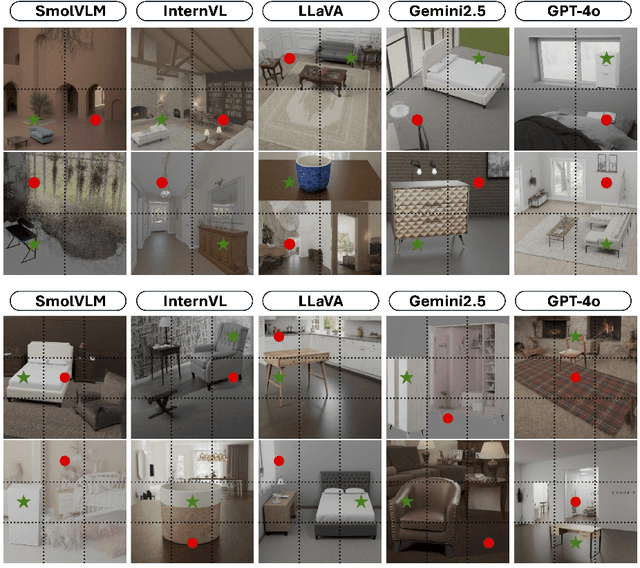
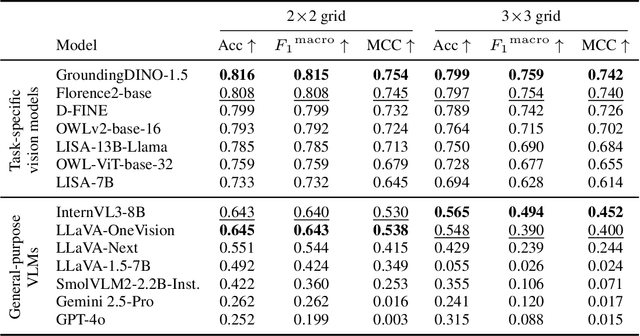
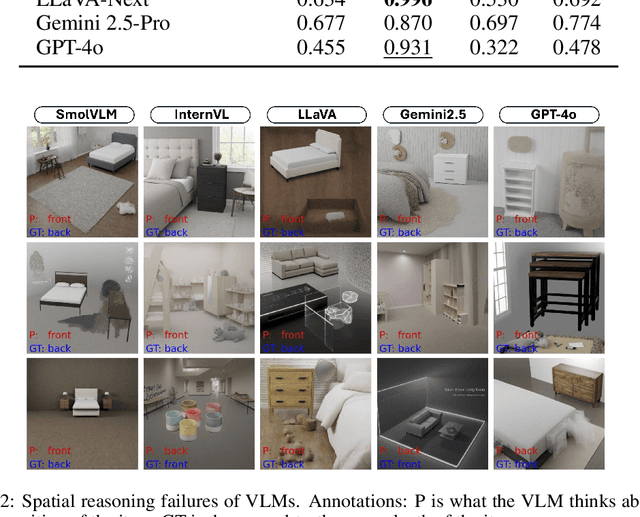
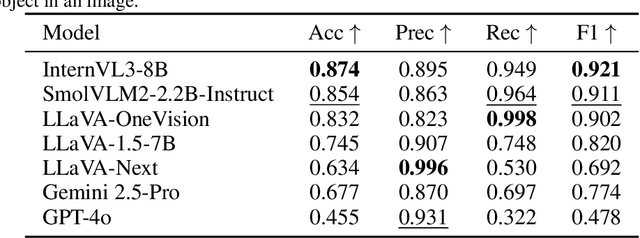
Abstract:Spatial understanding is a critical capability for vision foundation models. While recent advances in large vision models or vision-language models (VLMs) have expanded recognition capabilities, most benchmarks emphasize localization accuracy rather than whether models capture how objects are arranged and related within a scene. This gap is consequential; effective scene understanding requires not only identifying objects, but reasoning about their relative positions, groupings, and depth. In this paper, we present a systematic benchmark for object-centric spatial reasoning in foundation models. Using a controlled synthetic dataset, we evaluate state-of-the-art vision models (e.g., GroundingDINO, Florence-2, OWLv2) and large VLMs (e.g., InternVL, LLaVA, GPT-4o) across three tasks: spatial localization, spatial reasoning, and downstream retrieval tasks. We find a stable trade-off: detectors such as GroundingDINO and OWLv2 deliver precise boxes with limited relational reasoning, while VLMs like SmolVLM and GPT-4o provide coarse layout cues and fluent captions but struggle with fine-grained spatial context. Our study highlights the gap between localization and true spatial understanding, and pointing toward the need for spatially-aware foundation models in the community.
VL-CLIP: Enhancing Multimodal Recommendations via Visual Grounding and LLM-Augmented CLIP Embeddings
Jul 22, 2025Abstract:Multimodal learning plays a critical role in e-commerce recommendation platforms today, enabling accurate recommendations and product understanding. However, existing vision-language models, such as CLIP, face key challenges in e-commerce recommendation systems: 1) Weak object-level alignment, where global image embeddings fail to capture fine-grained product attributes, leading to suboptimal retrieval performance; 2) Ambiguous textual representations, where product descriptions often lack contextual clarity, affecting cross-modal matching; and 3) Domain mismatch, as generic vision-language models may not generalize well to e-commerce-specific data. To address these limitations, we propose a framework, VL-CLIP, that enhances CLIP embeddings by integrating Visual Grounding for fine-grained visual understanding and an LLM-based agent for generating enriched text embeddings. Visual Grounding refines image representations by localizing key products, while the LLM agent enhances textual features by disambiguating product descriptions. Our approach significantly improves retrieval accuracy, multimodal retrieval effectiveness, and recommendation quality across tens of millions of items on one of the largest e-commerce platforms in the U.S., increasing CTR by 18.6%, ATC by 15.5%, and GMV by 4.0%. Additional experimental results show that our framework outperforms vision-language models, including CLIP, FashionCLIP, and GCL, in both precision and semantic alignment, demonstrating the potential of combining object-aware visual grounding and LLM-enhanced text representation for robust multimodal recommendations.
Prompt Optimizer of Text-to-Image Diffusion Models for Abstract Concept Understanding
Apr 17, 2024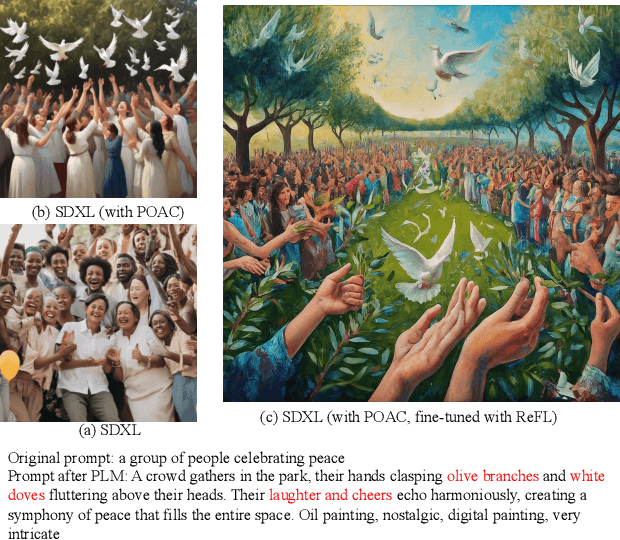
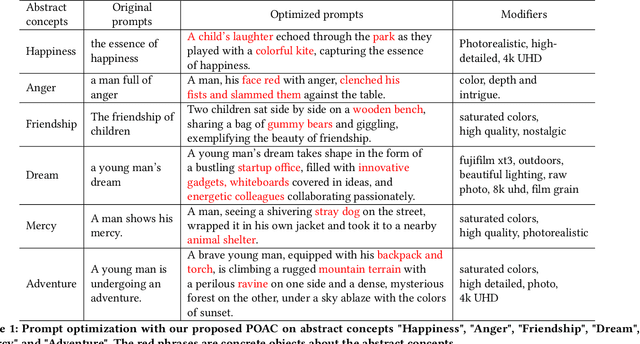
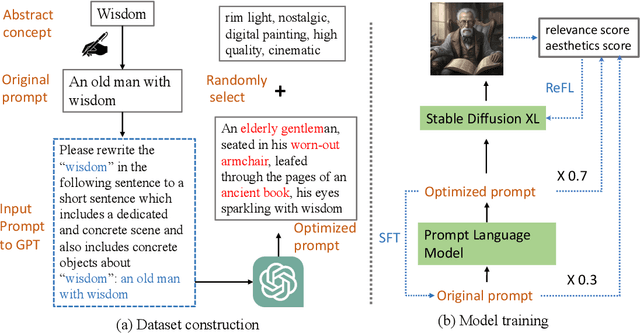

Abstract:The rapid evolution of text-to-image diffusion models has opened the door of generative AI, enabling the translation of textual descriptions into visually compelling images with remarkable quality. However, a persistent challenge within this domain is the optimization of prompts to effectively convey abstract concepts into concrete objects. For example, text encoders can hardly express "peace", while can easily illustrate olive branches and white doves. This paper introduces a novel approach named Prompt Optimizer for Abstract Concepts (POAC) specifically designed to enhance the performance of text-to-image diffusion models in interpreting and generating images from abstract concepts. We propose a Prompt Language Model (PLM), which is initialized from a pre-trained language model, and then fine-tuned with a curated dataset of abstract concept prompts. The dataset is created with GPT-4 to extend the abstract concept to a scene and concrete objects. Our framework employs a Reinforcement Learning (RL)-based optimization strategy, focusing on the alignment between the generated images by a stable diffusion model and optimized prompts. Through extensive experiments, we demonstrate that our proposed POAC significantly improves the accuracy and aesthetic quality of generated images, particularly in the description of abstract concepts and alignment with optimized prompts. We also present a comprehensive analysis of our model's performance across diffusion models under different settings, showcasing its versatility and effectiveness in enhancing abstract concept representation.
Temporally Precise Action Spotting in Soccer Videos Using Dense Detection Anchors
May 20, 2022
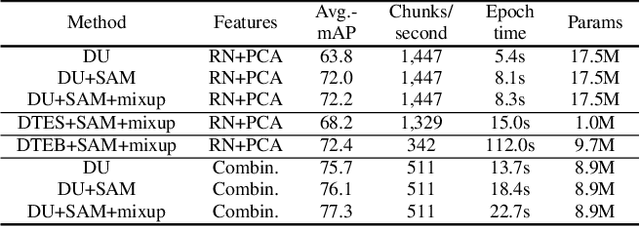
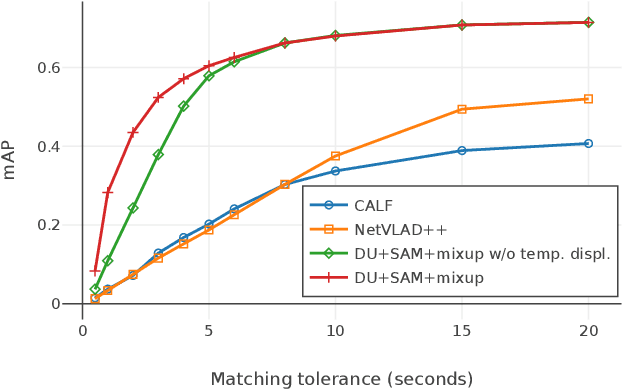
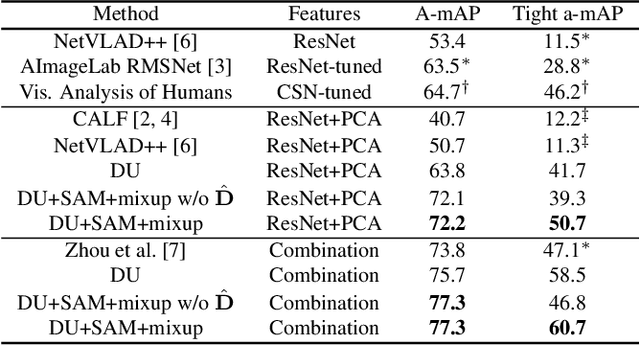
Abstract:We present a model for temporally precise action spotting in videos, which uses a dense set of detection anchors, predicting a detection confidence and corresponding fine-grained temporal displacement for each anchor. We experiment with two trunk architectures, both of which are able to incorporate large temporal contexts while preserving the smaller-scale features required for precise localization: a one-dimensional version of a u-net, and a Transformer encoder (TE). We also suggest best practices for training models of this kind, by applying Sharpness-Aware Minimization (SAM) and mixup data augmentation. We achieve a new state-of-the-art on SoccerNet-v2, the largest soccer video dataset of its kind, with marked improvements in temporal localization. Additionally, our ablations show: the importance of predicting the temporal displacements; the trade-offs between the u-net and TE trunks; and the benefits of training with SAM and mixup.
Distantly Supervised Semantic Text Detection and Recognition for Broadcast Sports Videos Understanding
Oct 31, 2021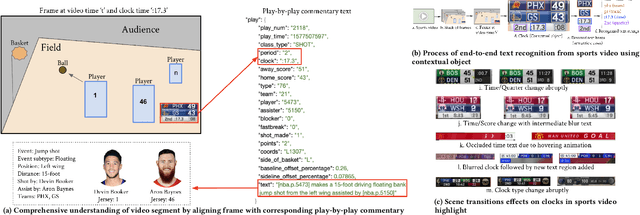
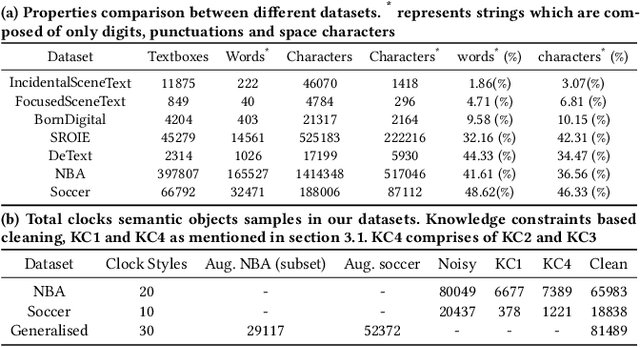

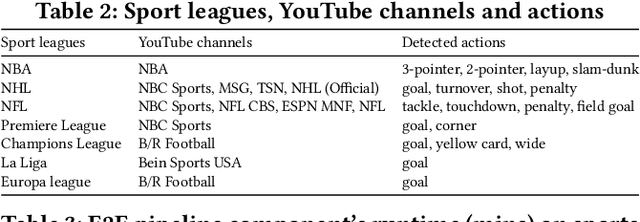
Abstract:Comprehensive understanding of key players and actions in multiplayer sports broadcast videos is a challenging problem. Unlike in news or finance videos, sports videos have limited text. While both action recognition for multiplayer sports and detection of players has seen robust research, understanding contextual text in video frames still remains one of the most impactful avenues of sports video understanding. In this work we study extremely accurate semantic text detection and recognition in sports clocks, and challenges therein. We observe unique properties of sports clocks, which makes it hard to utilize general-purpose pre-trained detectors and recognizers, so that text can be accurately understood to the degree of being used to align to external knowledge. We propose a novel distant supervision technique to automatically build sports clock datasets. Along with suitable data augmentations, combined with any state-of-the-art text detection and recognition model architectures, we extract extremely accurate semantic text. Finally, we share our computational architecture pipeline to scale this system in industrial setting and proposed a robust dataset for the same to validate our results.
 Add to Chrome
Add to Chrome Add to Firefox
Add to Firefox Add to Edge
Add to Edge